10 Best Software Development Methodologies for 2026
Date
Oct 29, 25
Reading Time
8 Minutes
Category
Custom development
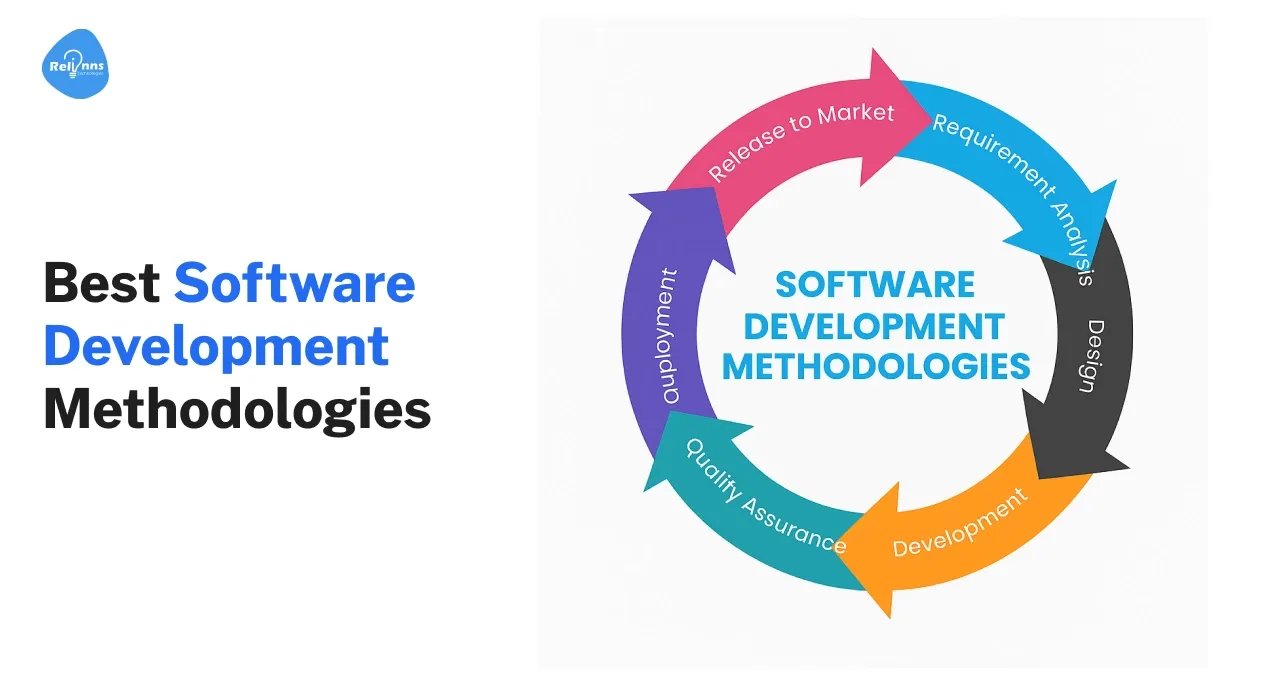
In 2026, software development continues to evolve rapidly. With increasing client expectations, remote teams, and AI-driven tools reshaping the delivery, the choice of software development methodologies can make or break your project.
These frameworks dictate how teams plan, build, test, and deploy software, defining the rhythm and success of the entire software development process.
From agile software development methodologies that emphasize collaboration and flexibility to traditional models like the Waterfall method, which prioritizes structure, each methodology fits a different need.
Let’s explore the 10 best software development methodologies for 2026, backed by real data, key features, and practical pros and cons to help you choose the right approach.
What Are Software Development Methodologies?
Software development methodologies are structured frameworks that guide teams through the software development life cycle (SDLC).
They define stages such as planning, designing, coding, testing, and maintenance.
The goal? Deliver high-quality software faster and more efficiently.
Some models, like Waterfall, follow a strict linear process. Others, like Agile or DevOps, encourage flexibility and iteration.
Understanding these software development methodologies examples ensures teams select the right one for their goals, resources, and timelines.
10 Software Development Methodologies for 2026
Did you know that 71% of companies now use Agile in their software development lifecycle?
As we head into 2026, the spectrum of software development methodologies extends beyond Agile, each with unique strengths tailored to different project needs.
1. Agile
Agile tops the list of software development methodologies for 2026. It emphasizes iterative progress, collaboration, and customer feedback.
Instead of a single long project cycle, work is divided into short, manageable sprints that promote adaptability and flexibility.
Key Features
- Iterative development with short, focused cycles known as sprints.
- Continuous feedback loops drive improvement and refine evolving requirements.
- Flexible scope enables adaptation to change at any stage.
- Cross-functional collaboration ensures shared ownership and faster decision-making.
- Deliverable software is produced at the end of each sprint for stakeholder review.
Pros and Cons
Pros | Cons |
| High adaptability to changes | Requires constant client involvement |
| Early detection of issues | Documentation may be less detailed |
| Better team collaboration | May cause scope creep |
| Faster delivery of usable modules | Needs disciplined project management |
| Customer satisfaction remains high | Can struggle with large teams |
Stats
- 86% of teams now adopt Agile approaches in their workflow.
- They also note that agile transformations can drive improvements of 30–50% in operational metrics, such as speed, predictability, and process efficiency.
2. Waterfall
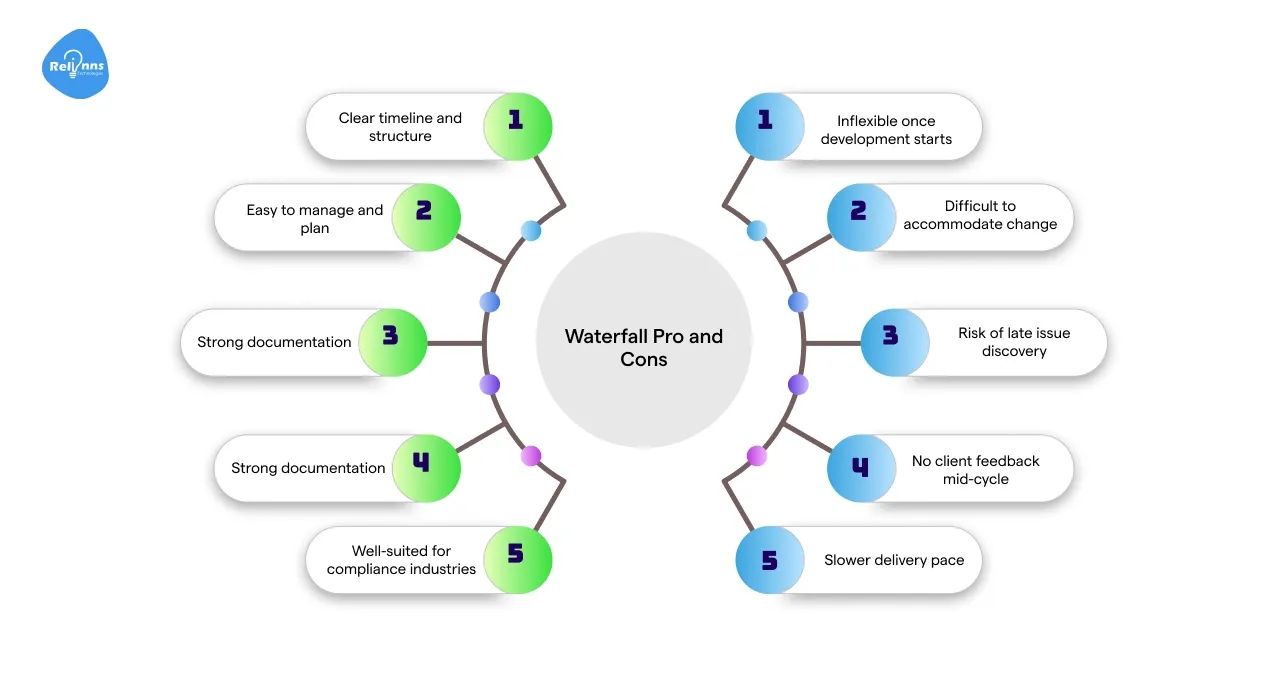
Waterfall remains one of the most structured and widely recognized examples of software development methodologies.
Each line’s phase must finish before the next begins. Best for projects with fixed requirements.
Waterfall model flow
“Requirements → System Design → Implementation → Testing → Deployment → Maintenance”
Key Features
- Sequential workflow covering requirements to deployment.
- Extensive documentation guarantees structured communication.
- Milestone-based tracking simplifies progress measurement throughout each phase.
- Stable requirements make it perfect for predictable, well-defined development efforts.
- Compliance-focused projects benefit from Waterfall’s strict process control framework.
Pros and Cons
Pros | Cons |
| Clear timeline and structure | Inflexible once development starts |
| Easy to manage and plan | Difficult to accommodate change |
| Strong documentation | Risk of late issue discovery |
| Ideal for fixed budgets | No client feedback mid-cycle |
| Well-suited for compliance industries | Slower delivery pace |
Stats
- Approximately 22% of legacy enterprise systems still rely on the Waterfall methodology. (Source: G2)
- Waterfall-based projects tend to take 20% longer than Agile ones. (Source: G2)
3. DevOps
DevOps combines software development and IT operations to achieve continuous delivery and reliability.
It eliminates silos between teams, creating a culture of collaboration and automation across the software development life cycle.
Key Features
- Continuous integration and deployment (CI/CD) ensure constant delivery cycles.
- Shared responsibility unites developers and operations for smoother collaboration.
- Automated testing, deployment, and monitoring minimize the risks associated with manual intervention.
- Real-time tracking provides visibility into performance across the entire pipeline.
- Collaborative culture drives innovation, efficiency, and operational accountability.
Pros and Cons
Pros | Cons |
| Faster software releases | Requires significant tooling setup |
| Fewer deployment failures | Demands cultural transformation |
| Improves quality assurance | Initial cost can be high |
| Increases operational visibility | Needs skilled engineers |
| Enhances team communication | Security integration adds complexity |
Stats
- 99% of organizations that implement DevOps report a positive effect.
- 61% of organizations say DevOps improved the quality of deliverables. (Source: Spacelift)
Suggested Reading: Best Custom Software Development Companies of 2026
4. Rapid Application Development (RAD)
RAD focuses on quick prototyping and iterative design rather than long planning phases.
It’s one of the best software development methodologies for teams aiming to deliver products quickly.
Key Features
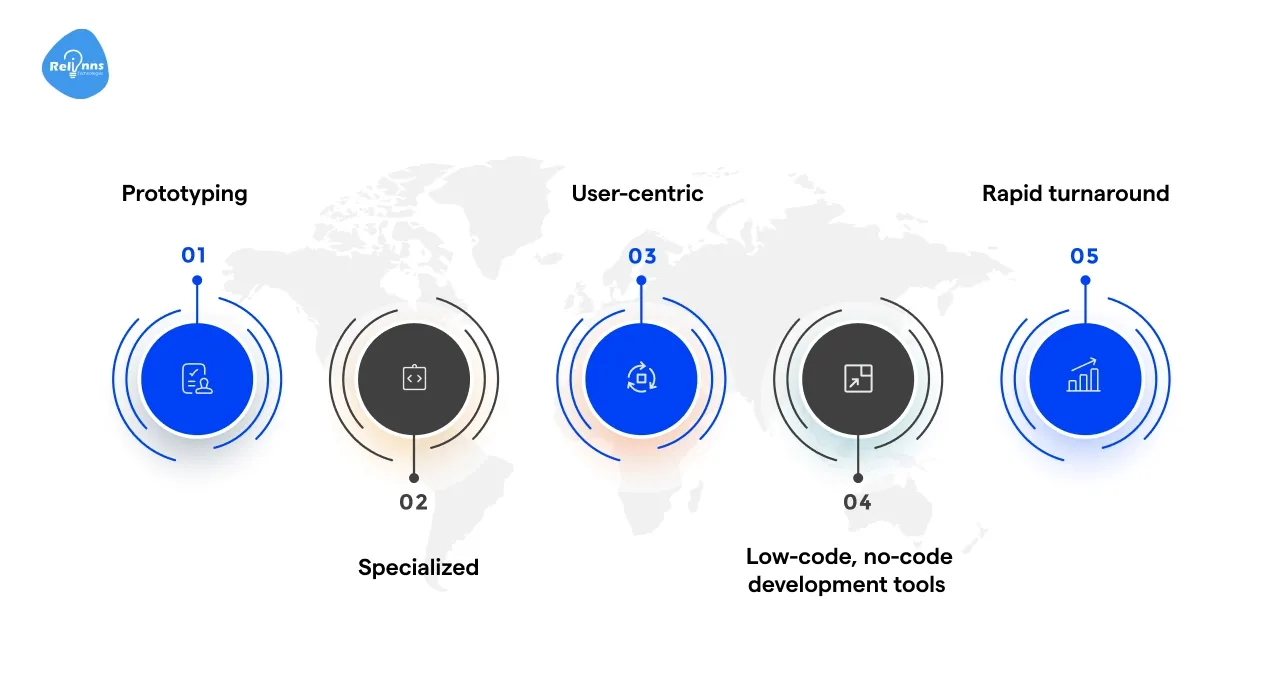
- Prototyping over documentation ensures faster visualization of project outcomes.
- Specialized small teams iterate quickly with focused development efforts.
- User-centric testing gathers early feedback for continuous product refinement.
- Low-code, no-code development tools accelerate design & implementation phases.
- Rapid turnaround reduces the gap between concept and product launch.
Pros and Cons
Pros | Cons |
| Speedy delivery | Not ideal for complex projects |
| Encourages user involvement | Requires skilled developers |
| Reduces development costs | Limited scalability |
| Adapts easily to changes | Lacks detailed documentation |
| Supports visual development tools | Works poorly for distributed teams |
Stats
- RAD enables up to 90% faster development vs traditional approaches.
- Gartner forecasts 70% of new business applications will use low-code/no-code by 2026.
5. Scrum
Scrum is an agile framework emphasizing short, time-boxed “sprints,” clearly defined roles, and constant communication between team members and stakeholders.
It’s designed to handle complex, evolving projects by fostering flexibility, transparency, and accountability.
Through frequent feedback loops, Scrum enables teams to adapt quickly, consistently deliver functional software increments, and ensure that every sprint contributes measurable value to the overall project goals.
Key Features
- Fixed-length sprints lasting one to four weeks per iteration
- Defined roles include Product Owner, Scrum Master, and Team.
- Daily stand-ups promote transparency, communication, and rapid progress.
- Backlog refinement ensures priorities align with evolving project goals.
- Iterative delivery provides working increments at the end of every sprint.
Pros and Cons
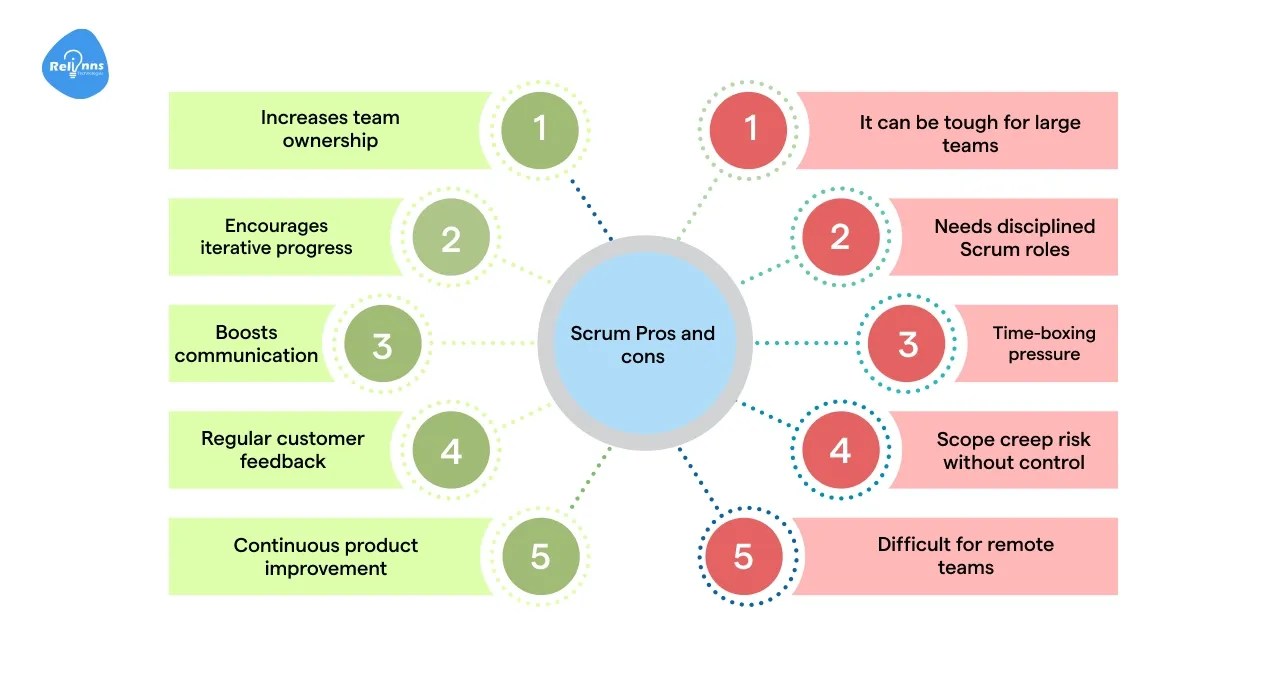
Pros | Cons |
| Increases team ownership | It can be tough for large teams |
| Boosts communication | Needs disciplined Scrum roles |
| Encourages iterative progress | Scope creep risk without control |
| Regular customer feedback | Difficult for remote teams |
| Continuous product improvement | Time-boxing pressure |
Stats
- 63% of team-level Agile users follow the Scrum methodology.
- 81% of Agile teams report using some version of Scrum.
6. Extreme Programming (XP)
XP emphasizes engineering excellence within agile software development methodologies. It focuses on continuous feedback, simplicity, and robust coding practices to ensure quality.
Designed for fast-paced environments, XP empowers teams to adapt rapidly while maintaining high code standards and consistent delivery.
Key Features
- Test-driven development (TDD) ensures reliability through pre-written automated tests.
- Pair programming enhances teamwork, knowledge sharing, and code consistency.
- Continuous integration merges new code frequently to avoid conflicts.
- Collective code ownership promotes shared responsibility and fast problem resolution.
- Frequent minor releases deliver incremental improvements and reduce integration risk.
Pros and Cons
Pros | Cons |
| Produces very high-quality code | Demands strong developer discipline |
| Reduces bugs through TDD | Time-consuming early on |
| Improves collaboration | Pair programming doubles the effort |
| Flexible to changes | Hard to scale beyond small teams |
| Encourages a learning culture | The customer must stay involved |
Stats
- TDD adoption can cut defect rates by up to 40%.
- 47% of Agile teams actively practice Test-Driven Development.
7. Feature-Driven Development (FDD)
Feature-Driven Development (FDD) is an agile software development model that focuses on building and delivering software through short, iterative cycles centered on specific features.
It combines the structure of traditional project management with the flexibility of agile principles, making it highly efficient for large, distributed teams.
By emphasizing modeling, planning, and feature ownership, FDD ensures consistent progress and high-quality outcomes across complex projects.
Key Features
- A model-driven approach defines structure and logic before any coding begins.
- Feature-based development builds software incrementally, focusing on user value.
- Two-week iterative cycles ensure the timely delivery of functional components.
- Progress monitoring tracks completion based on verified, delivered features.
- Defined class and feature ownership establishes accountability within large teams.
Pros and Cons
Pros | Cons |
| Predictable progress tracking | Needs strong domain modeling |
| Supports large teams | Hard for small projects |
| Clear reporting visibility | Can become process-heavy |
| Promotes ownership | Limited flexibility mid-cycle |
| Balances structure + agility | Less suited for innovation projects |
Stats
- Organizations implementing FDD achieve 60–80% improvement in business-IT alignment.
- FDD leads to ~50% reduction in requirements misunderstandings.
8. Spiral
The Spiral model combines iterative development with a risk-driven approach, ideal for large, complex, or mission-critical projects.
Each cycle emphasizes planning, design, implementation, and evaluation, ensuring continuous refinement. This method minimizes risk while allowing flexibility through constant feedback and analysis.
Key Features
- Risk-focused assessment is conducted carefully during every project iteration.
- Cyclic stages include planning, design, building, and evaluation phases.
- Prototype integration enables early validation and stakeholder-driven feedback loops.
- Refinement happens each cycle, improving outcomes from prior development rounds.
- Documentation remains comprehensive, ensuring traceability throughout the lifecycle.
Pros and Cons
Pros | Cons |
| Ideal for high-risk projects | Requires experienced teams |
| Detects problems early | Costly due to multiple iterations |
| Continuous stakeholder involvement | Harder to manage deadlines |
| Ensures robust documentation | Complex to implement |
| Scalable for large systems | Slower than Agile methods |
Stats
- Only one-third of waterfall projects finish on budget and schedule, a key reason Spiral’s risk-driven approach gained traction.
- NASA’s Manager’s Handbook recommends at least five re-estimates during the lifecycle to manage uncertainty, an approach aligned with Spiral’s iterative risk control.
9. Lean Development
Lean Development streamlines the software development process by eliminating waste and maximizing value.
It focuses on efficiency, continuous improvement, and team empowerment. This approach enables faster delivery, reduced costs, and higher customer satisfaction across the software development life cycle.
Key Features
- Waste elimination removes non-value-adding activities from development workflows.
- Quality is built into every stage, not inspected afterward.
- Continuous delivery enables faster value flow and minimal bottlenecks
- Empowered teams make decisions that drive ownership and accountability.
- Optimization focuses on improving the entire software process holistically.
Pros and Cons
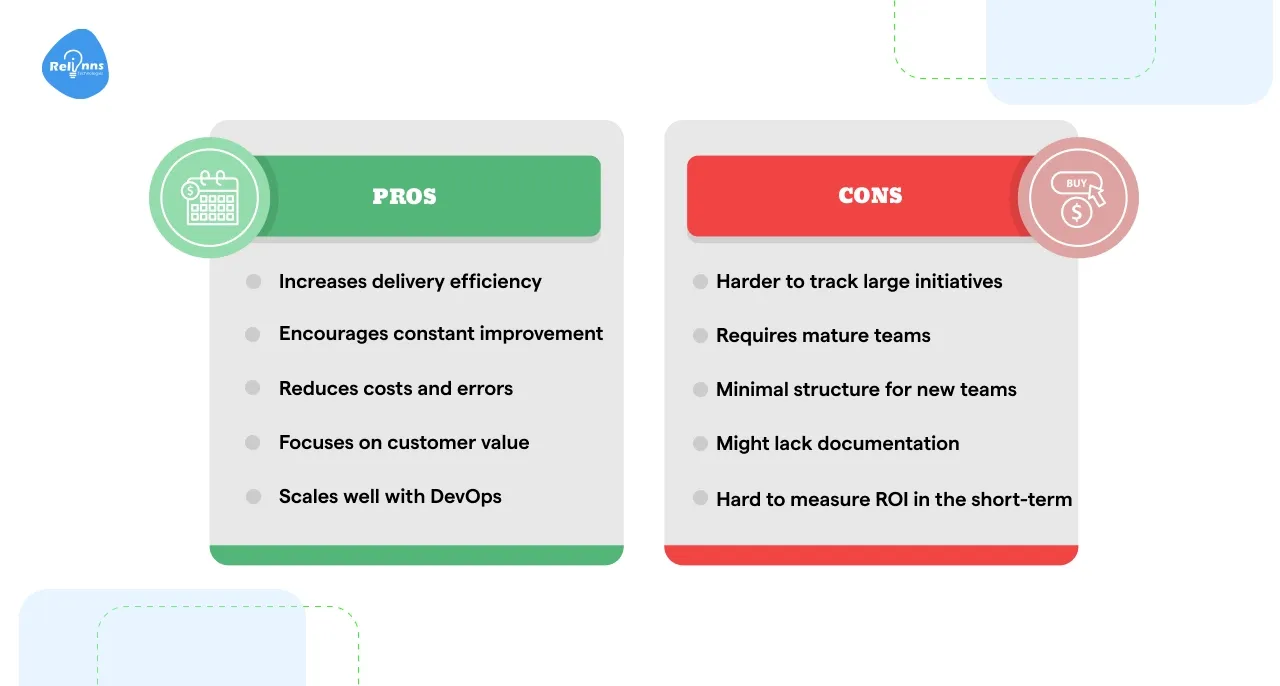
Pros | Cons |
| Reduces waste and inefficiency | Needs strong discipline |
| Empowers developers | Hard to quantify “waste” initially |
| Improves delivery speed | May under-document features |
| Encourages experimentation | Not suitable for regulated industries |
| Continuous process improvement | Requires cultural alignment |
Stats
- Products built with lean methodologies achieved 20% higher user satisfaction.
- According to a survey by the Lean Enterprise Institute, 70% of organizations reported improved productivity after implementing lean principles.
10. Lean Software Development
Lean Software Development (LSD) extends the principles of Lean to software engineering, emphasizing both speed and quality.
It follows seven core principles, such as eliminating waste, amplifying learning, and delivering quickly.
This approach empowers teams to innovate efficiently while maintaining customer value and continuous improvement.
Key Features
- Seven core Lean principles guide every stage of software development.
- Kanban boards visualize workflow, enhancing clarity and task tracking.
- Knowledge sharing promotes collaboration and continuous organizational learning.
- Small-batch releases ensure faster feedback and reduced deployment risks.
- Customer-focused development prioritizes value delivery over unnecessary complexity.
Pros and Cons
Pros | Cons |
| Increases delivery efficiency | Harder to track large initiatives |
| Encourages constant improvement | Requires mature teams |
| Reduces costs and errors | Minimal structure for new teams |
| Focuses on customer value | Might lack documentation |
| Scales well with DevOps | Hard to measure ROI in the short-term |
Stats
- Companies that applied lean practices saw 15–25% cost reductions in software projects.
- Lean projects are completed ~30% faster than traditional ones, while user satisfaction rises 20%.
Suggested Read: Best Custom Software Development Companies of 2026
Which software development methodology should I use?
Choosing the correct software development methodology depends on several key factors, including your team size, project complexity, budget, timeline, and risk tolerance. No single framework fits every situation, but understanding where each excels helps you make an informed decision.
A. For Startups
- Agile enables flexibility, quick pivots, and faster product delivery.
- Scrum encourages iterative sprints and the integration of rapid user feedback.
B. For Large Enterprises
- DevOps ensures automation, scalability, and continuous software deployment cycles.
- FDD improves coordination and structure across multiple, distributed development teams.
C. For Risk-Heavy Sectors
- Spiral manages risks through iterative validation and constant stakeholder review.
- Hybrid approaches enhance security, reliability, and compliance throughout the development process.
D. For Strict Compliance
- Waterfall provides thorough documentation and predictable, audit-ready project phases.
- V-Model ensures that each stage has corresponding verification and validation checks.
E. For Speed and Innovation
- RAD accelerates prototyping, enabling faster market entry and adaptability.
- Lean streamlines workflows to reduce waste and maximize business value.
Choosing the Right Software Development Methodologies in 2026
Choosing the correct software development methodology is more than a tactical decision; it shapes how quickly and reliably you deliver value.
Over the years, we’ve seen teams transition from waterfall rigidity to agile adaptability, DevOps automation, and hybrid strategies that balance risk, speed, and control.
Whatever your project scope or market demands, the method you adopt becomes the spine of your software development life cycle. Pair it with solid execution, and you dramatically elevate your odds of success.
Why Choose Relinns?
Relinns doesn’t just implement methodologies; we tailor them around your business goals, constraints, and team dynamics.
- Proven ROI: Relinns delivers Proof of Concept (POC) quickly, validating ideas before full development, resulting in tangible returns.
- Cost efficiency: Their low-code/automation expertise helps reduce IT costs by cutting tedious manual tasks.
- Scalability & integration: They build scalable systems with seamless integrations across CRMs, ERPs, and existing infrastructure.
- Compliance & domain strength: Relinns solves domain-specific challenges (e.g., HIPAA and KYC) across regulated industries.
- Ongoing support & optimization: They don’t just “deliver and vanish.” Relinns offers training, monitoring, and iterative improvement.
Partner with Relinns to transform your software vision into high-performing, sustainable solutions built with the correct methodology, delivered with precision, and optimized for growth.
Frequently Asked Questions (FAQ's)
What are the four types of agile methodology for software development?
The primary agile software development methodologies are Scrum, Kanban, Extreme Programming (XP), and Lean Development. Each focuses on adaptability, feedback, and collaboration, ensuring continuous improvement throughout the software development process.
How many methodologies are there in software development?
There are more than 15 well-known software development methodologies, but most fall under the agile, iterative, or traditional categories. Modern teams often blend methods (like Scrum + DevOps) to create hybrid frameworks.
What are the four types of programming methodologies?
The four common categories are Waterfall (linear), Agile (iterative), DevOps (continuous), and Rapid Application Development (RAD). Each governs the flow and efficiency of the overall software development life cycle.



